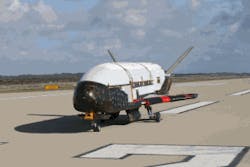Sea Avenger UAV model completes key wind tunnel test
Posted by John McHaleSAN DIEGO, 22 Feb. 2011. General Atomics Aeronautical Systems, Inc. (GA ASI) completed a key wind tunnel test on a model of its Sea Avenger unmanned aerial vehicle (UAV). Sea Avenger supports the Unmanned Carrier-Launched Airborne Surveillance and Strike (UCLASS) program by providing a long-endurance, survivable, carrier-based UAV for the U.S. Navy. The wind tunnel test validated the low-speed characteristics of a new wing, resulting in higher endurance and lower approach speeds. The new wing is also designed to increase aircraft dash speeds, decreasing the time to respond to potential threats.The 90-hour, eight-day test was conducted at the San Diego Air & Space Technology Center. The goal of the test, which was completed ahead of schedule, was to validate the low-speed characteristics of an updated wing in the approach, launch, and cruise configurations. The advanced design utilizes proprietary wing technology that enables high-speed flight, while also supporting excellent low-speed handling qualities desired for aircraft carrier landings. The testing enabled GA-ASI to evaluate a specific set of configuration changes quickly and economically. Wind tunnel testing also helps reduce program risk by providing empirical data to complement computational analyses. In addition, it provides the opportunity to correlate key performance data to analytical tools, such as computational fluid dynamics, and to validate various analytical methods. Designed for fully autonomous launch and recovery from both USS Nimitz and USS Ford class carriers, Sea Avenger provides unmanned, autonomous, and long-endurance intelligence, surveillance, and reconnaissance (ISR) capabilities responsive to the multi-mission requirements of carrier-based aircraft. The aircraft will provide for planning, control, tasking, collection, processing, analysis, and dissemination of actionable information in support of Navy missions.
